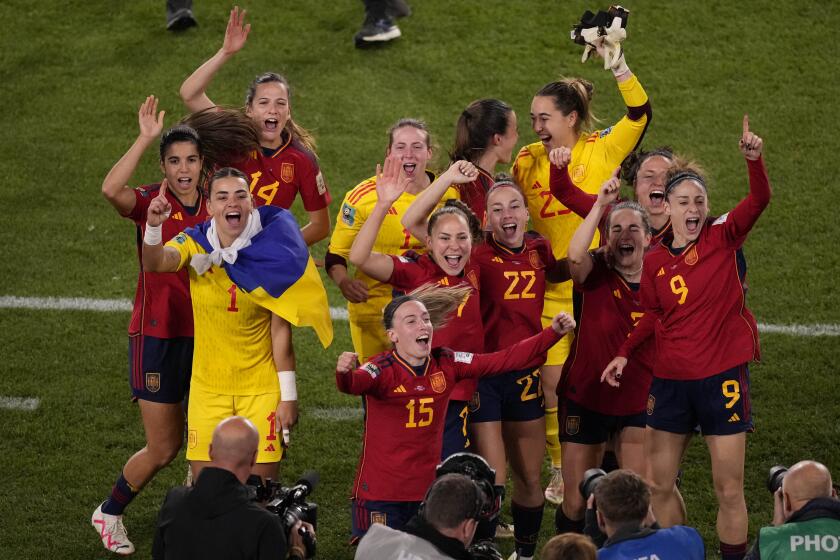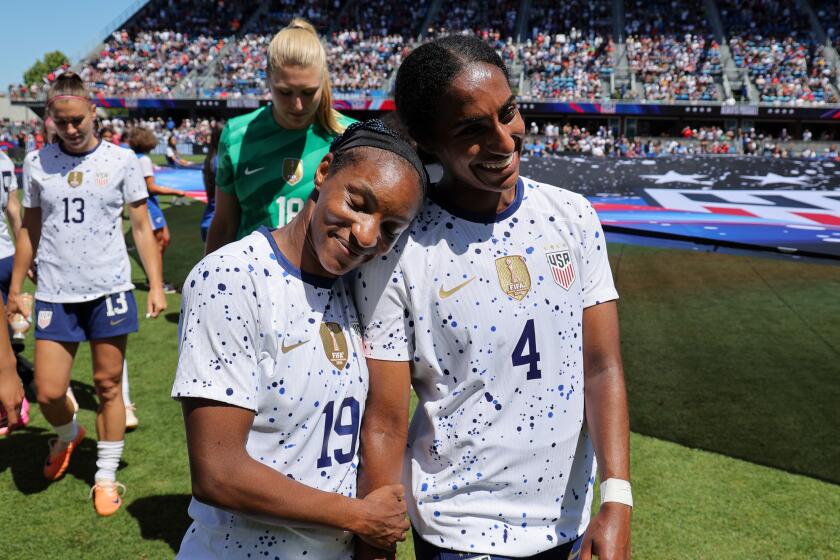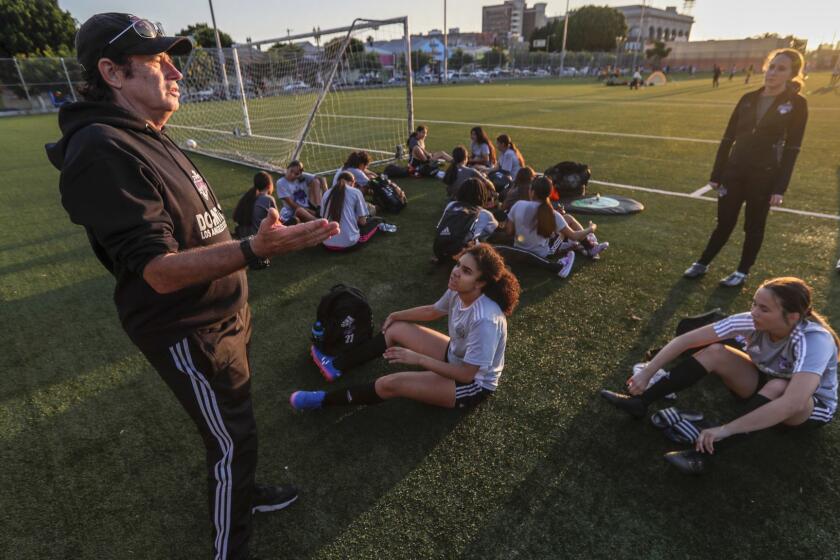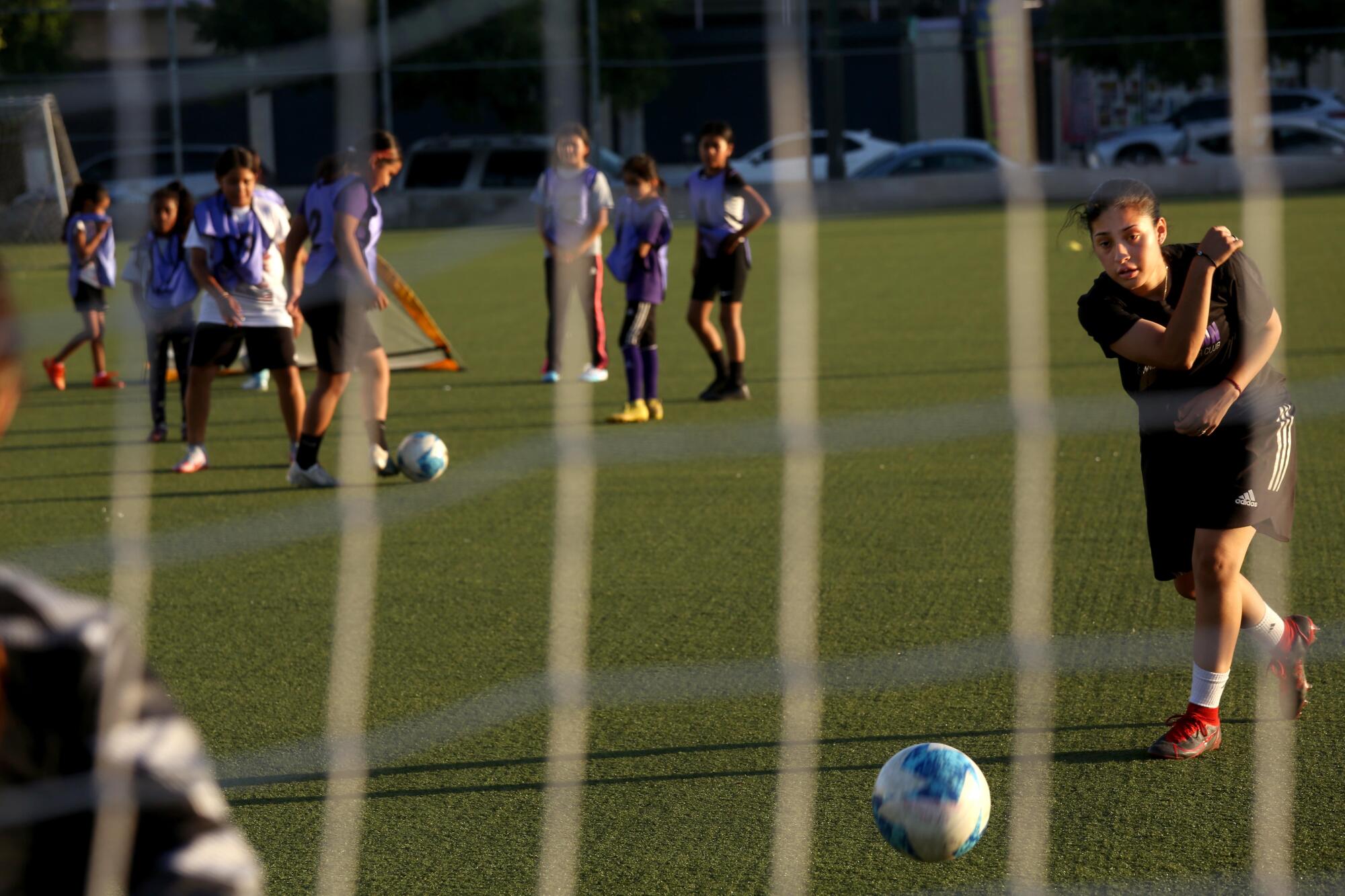
- Share via
The Lost Soccer Star is racing across a field she once dominated with blinding speed.
She’s now teaching little girls how to run.
“Move your hands, move your hands,” she shouts.
The Lost Soccer Star is shooting balls toward nets that she once filled with as many as nine goals a game.
She’s now teaching little girls how to kick.
“Follow your shot, follow your shot!” she shouts.
Nayelli Barahona, 19, is the best female soccer player to ever spread the beautiful game across this cluttered downtown Los Angeles pitch behind John Liechty Middle School.
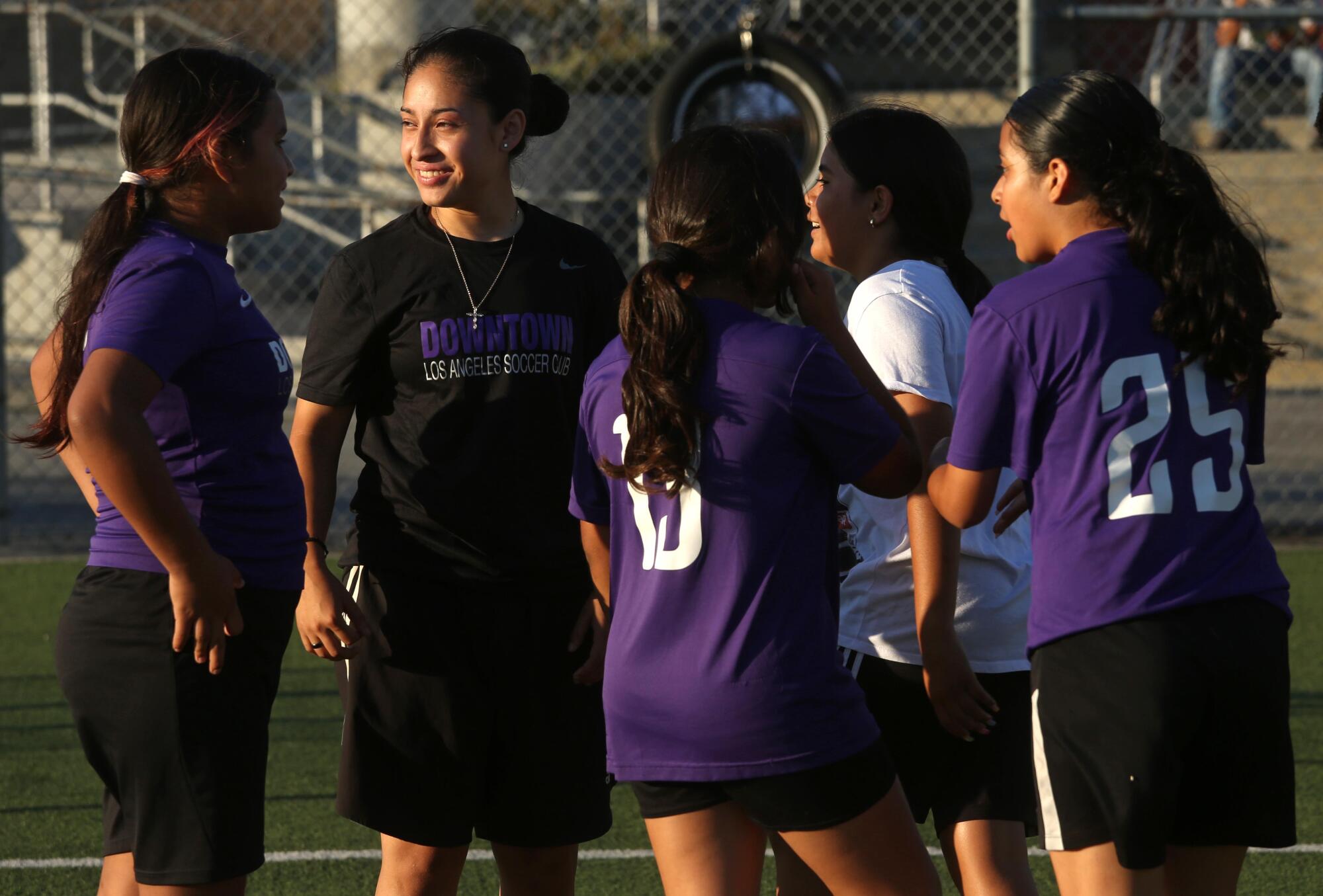
She has the sort of speed and creativity that was missing from the U.S. women’s national team during its recent World Cup debacle. She is precisely the sort of player who, if she entered the national program at a young age, could have grown into a force capable of picking up the U.S. women’s fallen torch.
But allegedly nobody from the U.S. Soccer Federation ever formally scouted her. Nobody with any national team influence ever ventured into Pico-Union to watch her fly.
She played for the greatly empowering but largely ignored Downtown Los Angeles Soccer Club, where the rosters are 95% Latina, 100% economically challenged and 0% on anybody’s radar.
They are champions, they are entertainers, they play at a breathtaking pace, yet they don’t fit the largely white and overwhelmingly rich feeder system that fuels American soccer.
“Our kids never have a chance, nobody from U.S. soccer has ever come to see them, it’s like their demographics almost don’t exist,” says club president Mick Muhlfriedel. “There is a big black hole in the middle of Southern California soccer, and we are that hole.”
Complete coverage of the 2023 FIFA Women’s World Cup in Australia and New Zealand from the Los Angeles Times.
So the Lost Soccer Star stayed lost.
During Barahona’s early teen years, a time when most soccer prospects are identified and sent to exclusive clubs by economically comfortable parents, she didn’t have the money or connections to even be noticed. By the time she was ready to go to college, her national team window had closed and there were no local scholarships available.
So she quit.
She would routinely score multiple goals a game, yet she quit. In her final season, she led her Downtown team to a state championship and a berth in the national regionals, yet she quit.
She now coaches Downtown 8-year-olds for free. She hasn’t even played in a pickup game in more than a month. And she didn’t watch any of the American World Cup games, because, even though she was born and raised here, America is no longer her team.
“Nobody on the team comes from my background, their stars don’t really look and play like me,” said the American-born daughter of Salvadoran immigrants. “This is my country, but that’s not my team.”
When the women’s World Cup began, the U.S. team bragged about its newfound diversity.
Among other minorities, a group that had no Latinas four years ago had two Mexican Americans and one young star, Alyssa Thompson, who is Black, Peruvian, Filipina and Italian.
However, when it came down to crunch time, the face of the U.S. team had barely changed. Of the seven women who attempted penalty kicks in the loss to Sweden, six were white.
“It looked like an old-timers game out there, and they played like it throughout the tournament,” said Muhlfriedel. “They need to broaden their search for players. They need to include all of the country, not just the white and wealthy.”
U.S. soccer needs to look at Muhlfriedel’s Downtown club, featured in this column four years ago and still banging its head against a green ceiling.
The USWNT World Cup roster includes seven Black women and two Mexican-Americans. “It’s something our teams takes a ton of pride in,” Megan Rapinoe says.
Downtown was founded 14 years ago when Muhlfriedel, a retired TV and movie composer, coached a Pico-Union girls American Youth Soccer Organization team. It was the only girls team in the largely Latino neighborhood, and soon he was flooded with aspiring strikers eager to overcome cultural roadblocks and join him.
“The hardest thing I had to do was convince these parents that the best soccer player in their house might not be their son, but their daughter,” said Muhlfriedel, 70.
He convinced parents by charging only $25 a month in a sport where top club teams charge between $3,000 and $7,000 a year. He picked up the girls at their homes throughout East and South Los Angeles and drove them to practice. He paid for uniforms, tournament fees, repossessed cars, immigration attorney’s fees, anything one could imagine that could give the girls the freedom to compete.
Their motto is, “If you can play, you can play,” and, goodness, how they have played, battling everything from broken lights at their practice field to racist hecklers at some of their games to become one of the top clubs in the state.
Downtown has since grown to 150 girls and 180 boys, their equipment is now supplied by Nike and they practice on a pristine green turf field that’s an oasis in the middle of their loud and cluttered neighborhood.
But they still feel like outsiders.
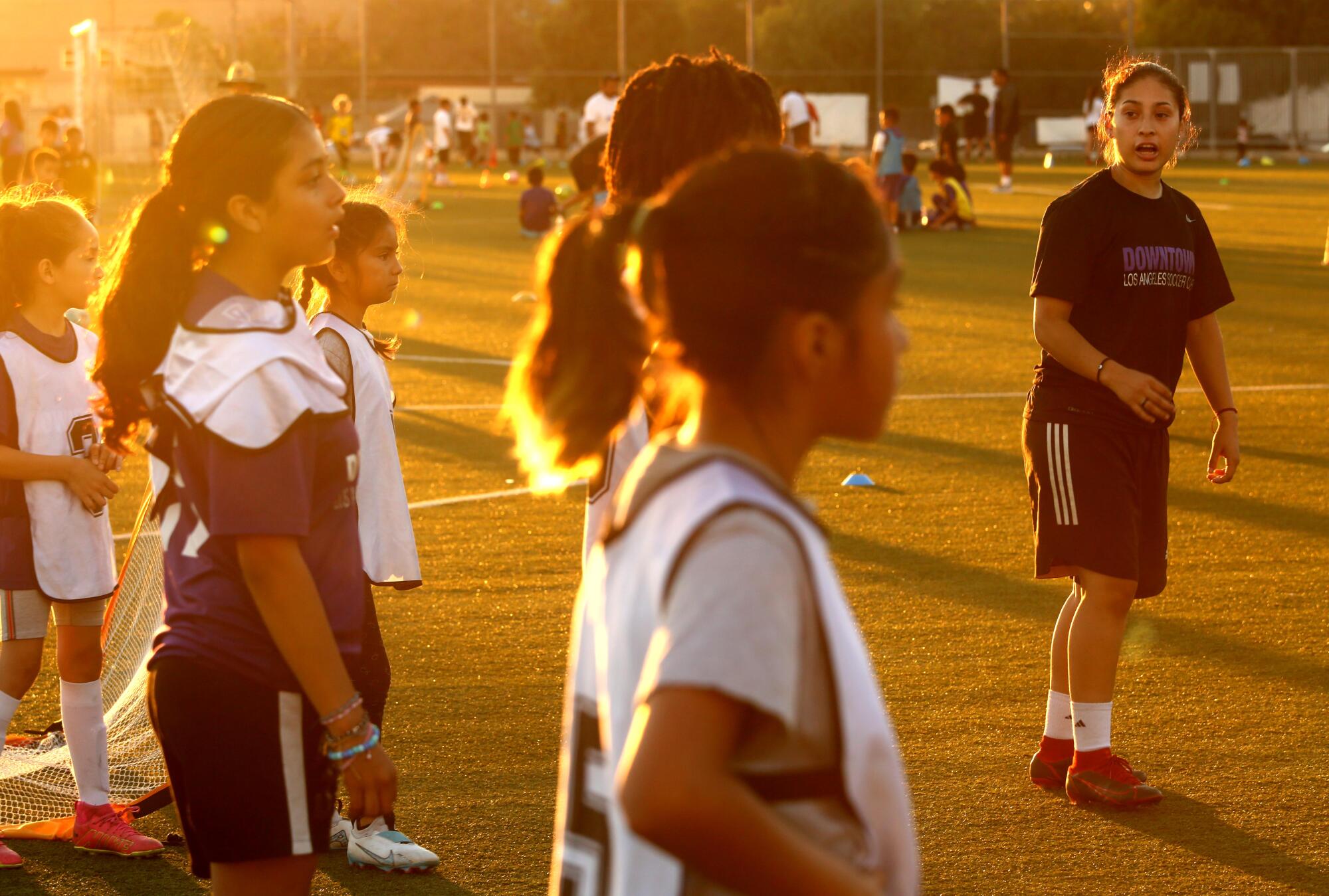
Last year when Barahona’s U19 team won the Cal South National Cup and advanced to the Youth Soccer Far West Regional Championships in Boise, Idaho, they were met with stares.
“It looked like a blond convention,” said Muhlfriedel. “We were the only Latina team, and they looked at us like we came from the moon.”
They advanced to the round of 16, which was a huge triumph in itself, but the unsettling environment stayed with the girls.
“Where we come from, where we are, it’s obvious it’s hard to break out,” said Barahona.
What’s also obvious is how much U.S. women’s soccer needs to help them break out by tapping into the sort of energy generated by the Downtown’s teams.
“Our kids never have a chance, nobody from U.S. soccer has ever come to see them, it’s like their demographics almost don’t exist. There is a big black hole in the middle of Southern California soccer, and we are that hole.”
— Downtown L.A. Soccer Club president Mick Muhlfriedel on barriers his players face
If there’s one lesson from this summer’s World Cup embarrassment, it’s that women’s soccer in America needs to be more inclusive, as the pipeline of young stars has been equaled or surpassed by the rest of the world.
The U.S. U20 team didn’t get out of the group stage in either the 2018 or 2020 world championships. The U17 team was beaten in the first knockout game in 2022 and lost in the group stage in 2014 and 2018.
Cindy Parlow Cone, the president of the U.S. Soccer Federation, acknowledged to The Times’ Kevin Baxter that the sport needs to be more inclusive.
“We still have a lot of work to make sure that every player, regardless of their background or where they live, have the opportunity and access to play our sport,” said Cone in a pre-World Cup interview. “That’s not true still in the U.S. And so that’s one thing that we as a federation are going to be working to really grow this game and increase the access to our game, so that not only our national teams, but every team across the country reflects the diversity of our country.”
It’s all too late for The Lost Soccer Star.
“I never got my time to shine,” said Barahona.
What a story she would have been.
She joined Downtown as a 9-year-old when she just showed up one day while tagging along with her cousin. She had never played organized soccer. She had learned the sport while watching Lionel Messi videos on YouTube and dribbling an old ball around her cramped backyard with her dogs, Max and Loba. Muhlfriedel was awed by her speed and immediately put her on a team.
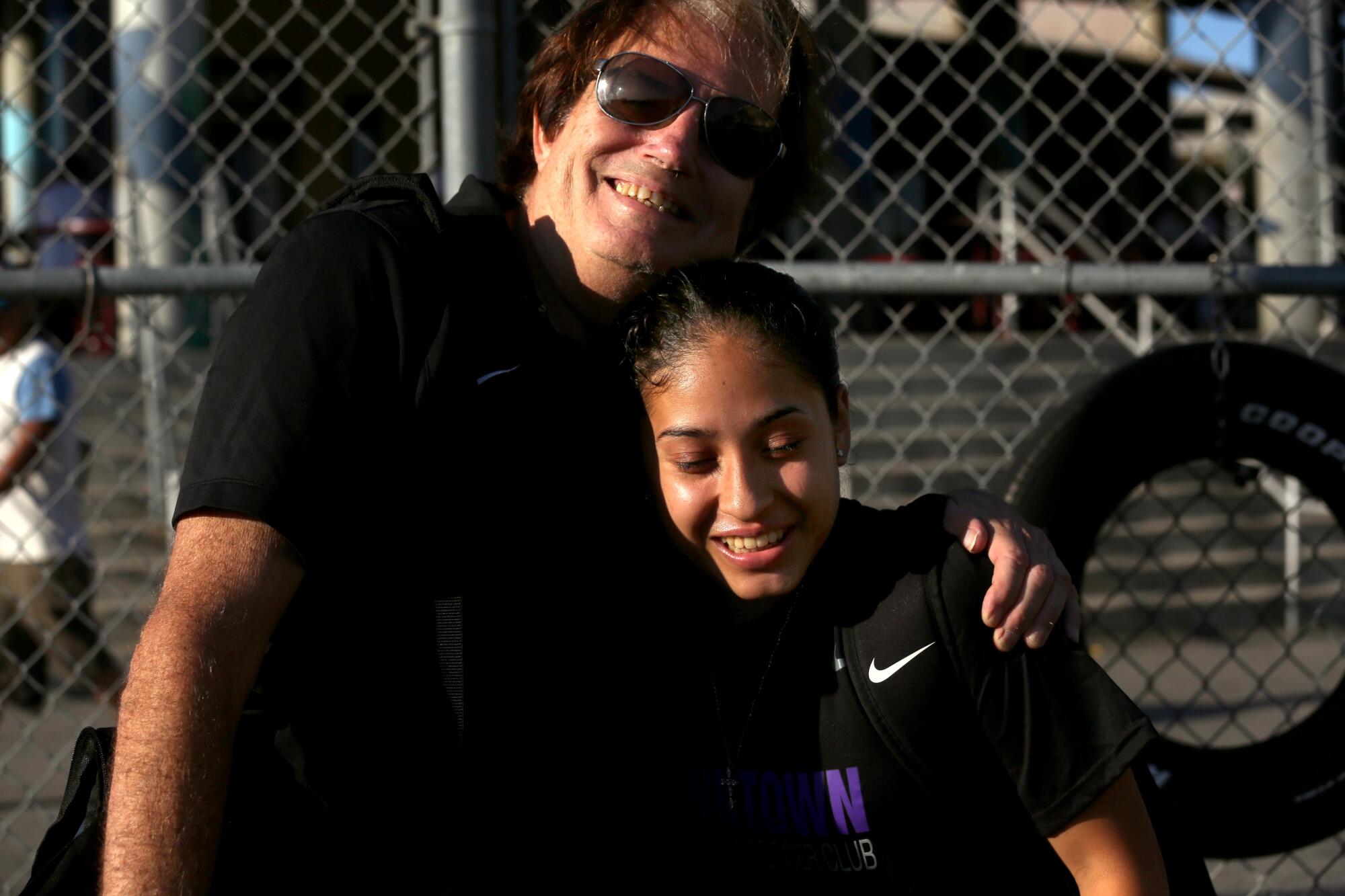
Everyone immediately took notice.
“She was the best I’ve ever seen,” said Muhlfriedel. “Everybody thought she was going to be the one.”
One of the original club members predicted greatness and didn’t even know her name.
“We all called her, ‘Little Messi,’’’ said Jimena Torres, now a club coach. “She scored amazing goals. I saw a huge future for her.”
Her former teammates echoed the sentiments.
“Best player I’ve ever watched,” said Luzy Erazo, also a Downtown coach. “The best striker I’ve ever met.”
Even opposing coaches were in awe.
“Nayelli is an amazing scorer because she can finish with either foot and she’s got serious pace,” said Catherine Davila, former coach and board president of Hollywood FC and current head of community and marketing at Angel City FC.
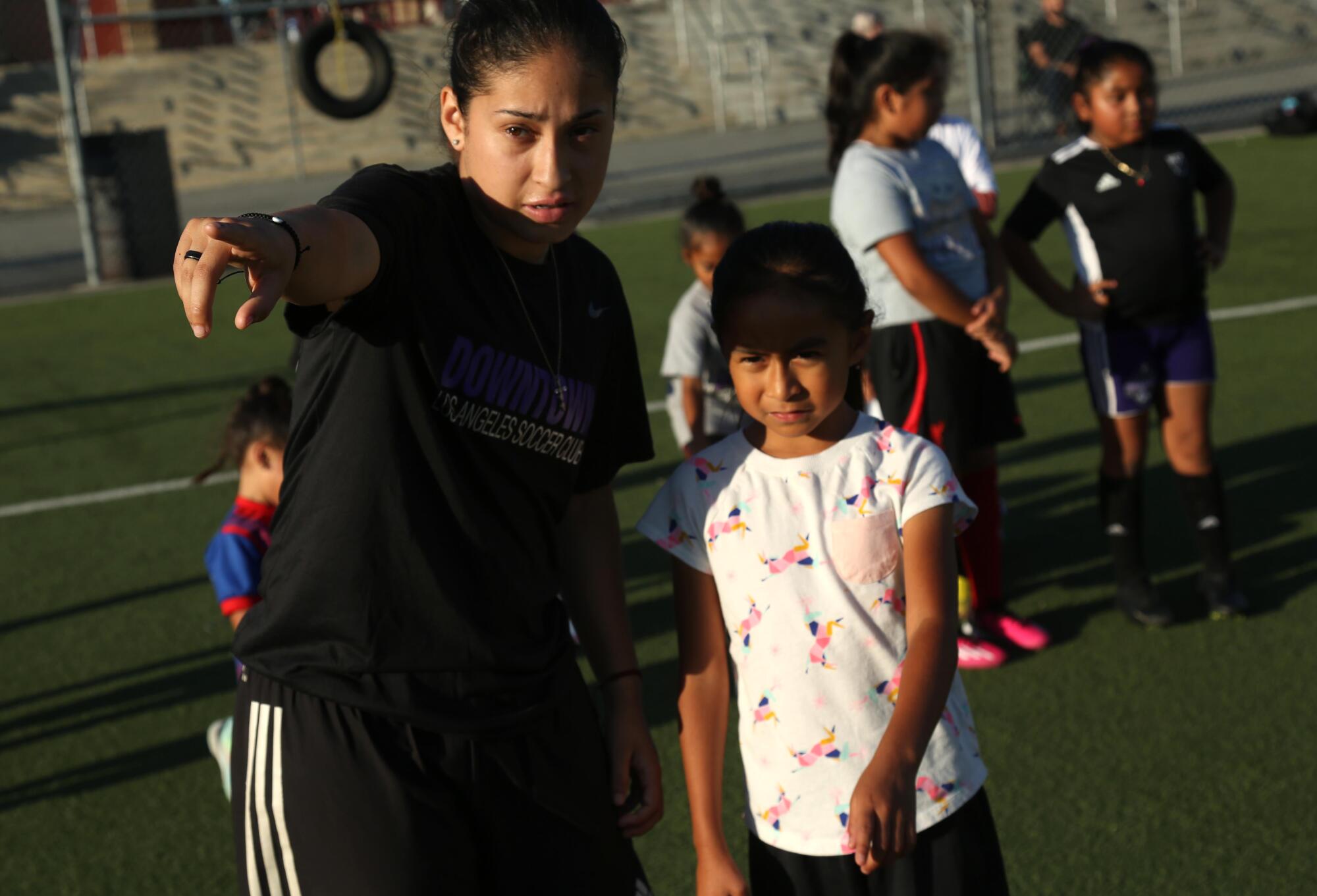
She added, “The beautiful thing about watching Nayelli play is that she seems most fully herself when she’s on the pitch. Her technical ability and soccer IQ are fantastic.”
Barahona played with a certain joy that lifted her above her humble surroundings. But as it became apparent that nobody seemed to notice, that joy slowly drained.
She didn’t have the money or access to join an influential club. She didn’t have the exposure to make the necessary connections.
“In this country it’s all connections and money,” said Torres. “Can you afford to play for the best clubs? And if you can’t, you don’t get seen.”
Barahona was increasingly resigned to making her magic in hiding, at a middle school field in the middle of soccer nowhere.
“Sometimes she would get sad and say, ‘You know, players like me never make it,’” said Erazo. “And that’s unfair. That sucks.”
Added former teammate and current club coach Marianna Hernandez: “We feel forgotten. We feel discriminated against. It’s the economic situation. It’s the race situation. She should have made it.”
The issue is compounded for Latina women because of the slowly dying cultural norms that exist in households where the male child is provided with the kind of athletic support not offered to the women. For example, Barahona may be a local legend, but her father has never seen her play.
“There is so much pressure on these girls, because so many times, their families want them to stay home and do their chores,” said Barahona, who credits her mother and grandmother for support. “There’s just a lot of things working against us.”
It’s a steamy Saturday morning in Norco, and the girls from downtown are flying.
Barahona received college scholarship feelers from out-of-state schools, but she didn’t want to leave her community. No local schools made any offers. She initially attempted to walk on at Long Beach State but became frustrated at her lost opportunities and finally just walked away to become a full-time student majoring in psychology at the school.
“I didn’t get to show my potential, things didn’t happen the way I thought they would,” she said. “It was a tough pill to swallow.”
Listen to the experts, and it’s a pill that’s completely avoidable.
“I can’t honestly say how her soccer career would have been inflected had she been at a different club, one that was larger or better known, but I can say definitively that that is the dream that clubs in SoCal are selling,” said Davila. “From where I sit, the goal shouldn’t be for any particular player to be at any particular club, but rather for our development and identification system to get better and finding the gems who, for reasons of cost, distance or anything else out of their control can’t access the pay-to-play pathways we’ve built.”
That pathway has been blocked, but, reenergized by coaching the youngsters, Barahona is plotting a comeback. In the coming weeks, she’s going to try out for USC, which is the epitome of optimism because she has no idea how she would pay for tuition if she is accepted. More compelling, she will also try out for a national team.
Although it’s not the nation she once envisioned.
The next time you hear about Nayelli Barahona, she might be forgotten no more, as she could be taking her talents to a team that looks like her and feels like her in ways that the staid American team can never imagine.
El Salvador awaits.
More to Read
Go beyond the scoreboard
Get the latest on L.A.'s teams in the daily Sports Report newsletter.
You may occasionally receive promotional content from the Los Angeles Times.

